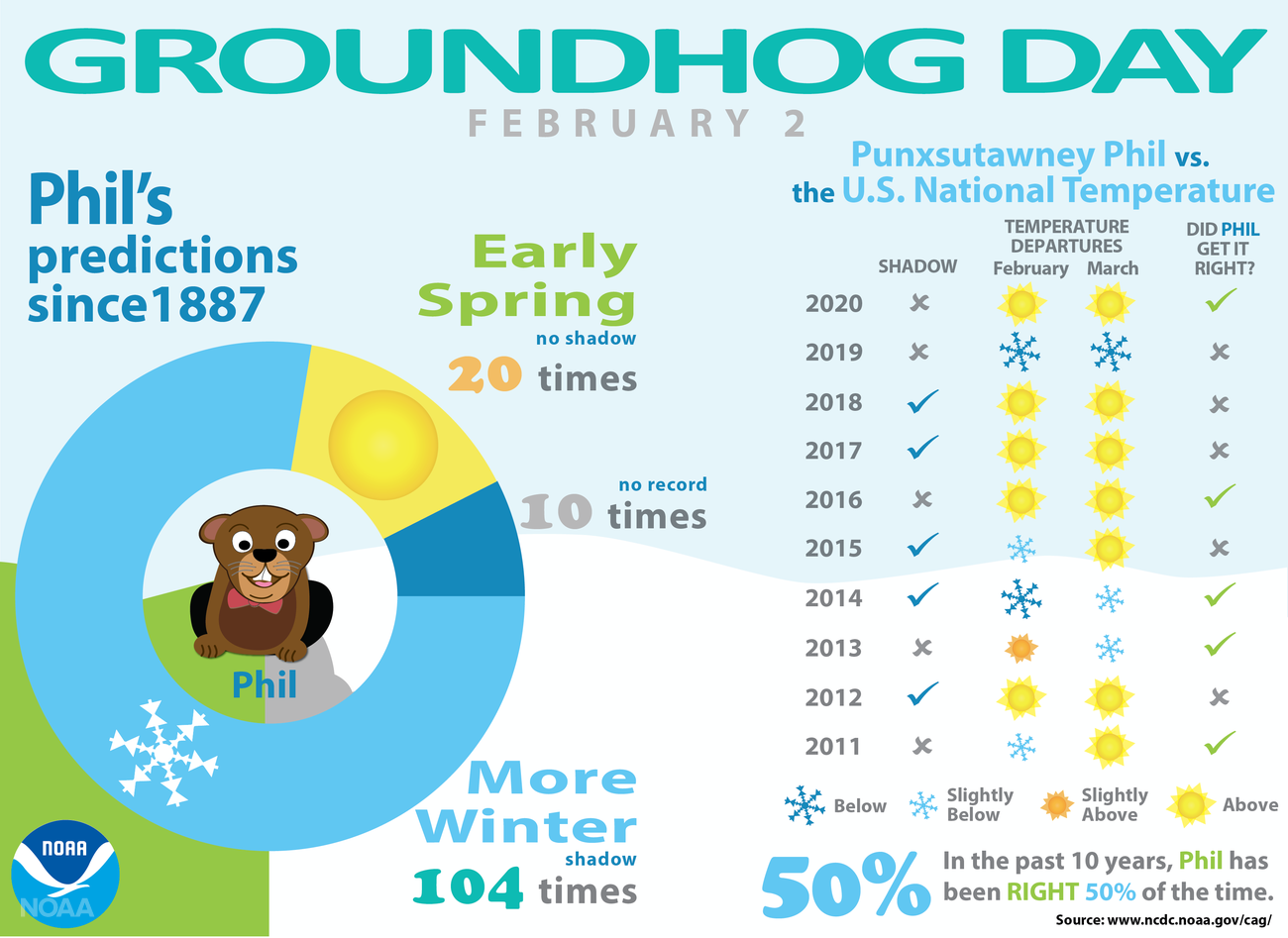The Groundhog vs. the 2020 Temperature Record: Keeping Score
Special Stories
3 Feb 2021 2:30 AM
[Written from NOAA and NOAA NCEI] In Gobbler's Knob, Pennsylvania, at the crack of dawn Tuesday morning, the nation's most famous groundhog Punxsutawney Phil saw his shadow, meaning six more weeks of winter, accordingly to longstanding folklore.
https://www.youtube.com/watch?v=qwMnkRspBTY&feature=emb_logo
 [Image from NOAA via iStock]
During March 2020, the average contiguous U.S. temperature was 46.1°F, 4.6°F above the twentieth-century average. This ranked as the 10th-warmest March in the 126-year period of record.
Above-average temperatures were observed from the Rocky Mountains to the East Coast. Record warmth was observed across most of the Gulf Coast, and contributed to the warmest March on record for Florida. Seventeen additional states from Texas to New England experienced a top-10 warm month. The Alaska March temperature was 12.0°F, 1.2°F above the long-term average. This ranked in the middle third of the 96-year period of record for the state and was the coldest March since 2017.
[Image from NOAA via iStock]
During March 2020, the average contiguous U.S. temperature was 46.1°F, 4.6°F above the twentieth-century average. This ranked as the 10th-warmest March in the 126-year period of record.
Above-average temperatures were observed from the Rocky Mountains to the East Coast. Record warmth was observed across most of the Gulf Coast, and contributed to the warmest March on record for Florida. Seventeen additional states from Texas to New England experienced a top-10 warm month. The Alaska March temperature was 12.0°F, 1.2°F above the long-term average. This ranked in the middle third of the 96-year period of record for the state and was the coldest March since 2017.
 [Image from NOAA via iStock]
[Image from NOAA via iStock]
 As Phil surely knows, accurate seasonal forecasting is hard work. Predicting the arrival of spring for an entire country, especially one with such varied regional climates as the United States, isn’t easy! The above graphic show's Phil's accuracy rate at about 40% over the last decade. More of Phil’s past predictions are also available from the Punxsutawney Groundhog Club.
As Phil surely knows, accurate seasonal forecasting is hard work. Predicting the arrival of spring for an entire country, especially one with such varied regional climates as the United States, isn’t easy! The above graphic show's Phil's accuracy rate at about 40% over the last decade. More of Phil’s past predictions are also available from the Punxsutawney Groundhog Club.
How accurate was Phil's 2020 forecast?
In 2020, Phil forecast a "short winter" when he did not see his shadow and predicted an early spring. In fact, the contiguous United States saw above-average temperatures in both February and March of last year.
The average contiguous U.S. temperature during February 2020 was 36.2°F, 2.3°F above the twentieth-century average. This ranked among the warmest one-third of the 126-year period of record. Much-above-average temperatures were observed across parts of the Mid-Atlantic and Northeast as well as portions of California and Florida. New Jersey ranked third warmest, while Rhode Island and Delaware ranked fifth warmest. However, below-average temperatures were observed across portions of the central Rockies to western Texas and also in Alaska during February. The Alaska February temperature was 1.6°F, 3.2°F below the long-term average. This ranked among the coldest one-third of the 96-year period of record for the state and was the coldest February since 1999. [Image from NOAA via iStock]
During March 2020, the average contiguous U.S. temperature was 46.1°F, 4.6°F above the twentieth-century average. This ranked as the 10th-warmest March in the 126-year period of record.
Above-average temperatures were observed from the Rocky Mountains to the East Coast. Record warmth was observed across most of the Gulf Coast, and contributed to the warmest March on record for Florida. Seventeen additional states from Texas to New England experienced a top-10 warm month. The Alaska March temperature was 12.0°F, 1.2°F above the long-term average. This ranked in the middle third of the 96-year period of record for the state and was the coldest March since 2017.
[Image from NOAA via iStock]
During March 2020, the average contiguous U.S. temperature was 46.1°F, 4.6°F above the twentieth-century average. This ranked as the 10th-warmest March in the 126-year period of record.
Above-average temperatures were observed from the Rocky Mountains to the East Coast. Record warmth was observed across most of the Gulf Coast, and contributed to the warmest March on record for Florida. Seventeen additional states from Texas to New England experienced a top-10 warm month. The Alaska March temperature was 12.0°F, 1.2°F above the long-term average. This ranked in the middle third of the 96-year period of record for the state and was the coldest March since 2017.
However, California ranked cooler than average with five additional Western states ranking near average for the month.
Phil's First Forecast
 [Image from NOAA via iStock]
[Image from NOAA via iStock]
In 1887, when he made his debut as the official groundhog forecaster for the entire country, Phil saw his shadow. His first prediction of six more weeks of winter was accurate for a few regions, but it came up short for several others.
According to the February 1887 Monthly Weather Review Form, the Northeast, Great Lakes region, and West saw temperatures well below normal. The Southeast and Gulf states saw temperatures well above normal during the month. And, according to the March 1887 Monthly Weather Review Form, the Northeast, Great Lakes region, Ohio Valley, and Southeast saw temperatures well below normal. Areas west of the Mississippi River valley saw temperatures above normal.What's the long-term scorecard say?
 As Phil surely knows, accurate seasonal forecasting is hard work. Predicting the arrival of spring for an entire country, especially one with such varied regional climates as the United States, isn’t easy! The above graphic show's Phil's accuracy rate at about 40% over the last decade. More of Phil’s past predictions are also available from the Punxsutawney Groundhog Club.
As Phil surely knows, accurate seasonal forecasting is hard work. Predicting the arrival of spring for an entire country, especially one with such varied regional climates as the United States, isn’t easy! The above graphic show's Phil's accuracy rate at about 40% over the last decade. More of Phil’s past predictions are also available from the Punxsutawney Groundhog Club.All Weather News
More